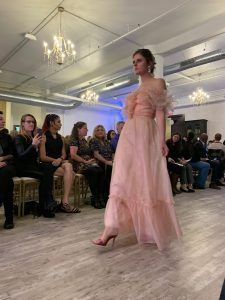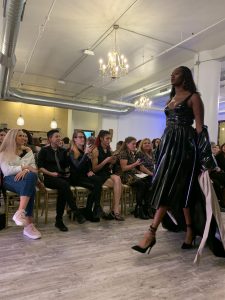Flyover Fashion

FLYOVER FASHION
Who says cheeseheads can't be chic?
“Cheesehead” has probably appeared in Vogue a pretty limited amount of times over the course of the so-called fashion Bible’s reign; however, a moment in September 2019 gave the publication reason to expand its vocabulary.
The Spring 2020 ready-to-wear collection for Virgil Abloh’s high-end streetwear label, Off-White, served as an “ironic homage,” according to the fashion show’s notes, to Abloh’s alma mater — UW-Madison. A repetitive Swiss-cheese-like hole motif and patterns resembling the coat of a spotted cow characterized the line of cargo pants, track suits, chunky boots and bags. The tribute to the dairy state was literal and prevalent enough for “Wisconsin” and famous supermodel “Gigi Hadid” to be uttered (or should I say, uddered?) within mere sentences of one another.
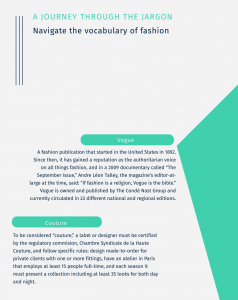 While Wisconsin may be better known for its leading agriculture, livestock and transportation machinery industries, it also serves as the launchpad, home and inspiration to designers in tenacious pursuit of success in the multibillion dollar global fashion industry. For some hopeful fashion professionals, Wisconsin is a classroom from which they plan to graduate; but for others, it’s the focal point of their fashion blueprint.
While Wisconsin may be better known for its leading agriculture, livestock and transportation machinery industries, it also serves as the launchpad, home and inspiration to designers in tenacious pursuit of success in the multibillion dollar global fashion industry. For some hopeful fashion professionals, Wisconsin is a classroom from which they plan to graduate; but for others, it’s the focal point of their fashion blueprint.
In fashion in Milwaukee
The industrial history of Milwaukee was on display as attendees approached the site of the city’s fifth annual fashion week, held on a dimly lit street lined with old-looking brick buildings. The event’s opening night in October was undetectable from the street, as the nondescript, unmarked building blended in among the rest of its counterparts. Once visitors made their way past the entrance, the interior stood in bright white juxtaposition to its curb appeal. The backdrop to Milwaukee Fashion Week was decorated and set up like a wedding Pinterest board come to life. The light and airy room was filled with gold Chiavari silhouette chairs, and the exposed industrial piping on the ceilings was offset by greenery mounted on the white cinder-block walls.
Adding color to the space, evidently, was left to the designers and crowd.
As the room filled up, the picture of Milwaukee’s fashion scene was slowly painted — stroke by unprecedented stroke. In part, the room looked like a family gathering — a wedding, perhaps — of a very stereotypical, white Wisconsinite family: mothers in modest chunky sweaters trying to take selfies with reluctant daughters in blouses and jeans, husbands and wives in their just-came-from-work-attire searching the room for a pair of empty seats, and crying babies in the arms of their grandmothers being rocked near the bathroom.
Standing in stark contrast to the sea of sensible footwear, some entered the room with a sense of confidence and belonging demonstrated by their outfit choices. Those looking the part of an archetypical fashionable crowd were dressed in head-to-toe black, accessorized by enigmatic vibes of aspirational cool.
Those daring to make a statement dressed in everything from blue fur coats and sequin jackets to full cheetah print ensembles and hair tied up with chopsticks, accessorized by sunglasses that would fit in a ’90s Jennifer Lopez music video and hoop earrings just grazing the tops of collar bones. When the event’s emcee later said, “Yes to drama, yes to glamour,” she captured the sentiment of half the crowd.
“Glamourous” wasn’t necessarily top of mind for show attendee Kimberly Green when she remarked that the collection of show-goers seemed “daytime-y.” Green, a Milwaukee-based, blue-haired, ex-biology teacher turned full-time fashion blogger and designer, wore a handmade rainbow jacket that sparkled under the bright lights — which remained on for the duration of the entire show.
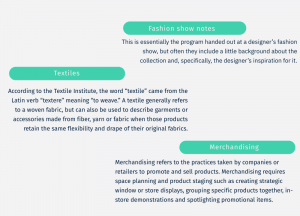 While Green said she came to Milwaukee Fashion Week’s opening night to support and see the work of local designers, social media influencer Pamela Kieck said she looked forward to the area’s small fashion community coming together.
While Green said she came to Milwaukee Fashion Week’s opening night to support and see the work of local designers, social media influencer Pamela Kieck said she looked forward to the area’s small fashion community coming together.
For Kieck, who hosted the second night of the fashion week event, Wisconsin has always been home, except for the brief time she worked in a corporate position in Minneapolis. She says isolation and boredom became the match to her creative flame and inspired her to take the opportunity to start her own blog, itspamelakieck.com. After taking the plunge to move back to Milwaukee and work on her blog full time, Kieck was one of the first fashion influencers in the area.
“Now [Milwaukee’s fashion scene is] growing a lot, and we’re all very close knit and support each other,” she says, attributing that to the nature of pursuing the practice of fashion blogging in a city like Milwaukee.
Designs from local talent satisfied a wide range in fashion appetites. The opening night featured looks from Anke Wonder, who veered toward the eclectic side. During the showing for this collection, models wore faux bird nests and feathers atop heads of braided hair. One male model carried a very realistic fake parrot in the crux of his arm as he marched down the runway in pastel blue shorts, paired with a button-down shirt made from busy patterned fabric in Mardi Gras colors. Looks curated by GG Collections decorated models’ bodies in the most boldly ambitious ways — tiger prints, bright colors, capes and headdresses. There was also a collection presented by Femme Alter Ego — a line of lingerie for whom the models essentially stripped down to strut in, leaving little enough to the imagination that a concerned woman placed a hand over their watching partners’ eyes.
It appeared as though the Milwaukee fashion scene and the talent displayed on the runway was somewhat of a microcosm of the fashion industry as a whole — encompassing various, polarizing tastes.
Milwaukee hosted its fifth annual fashion week in October. (Photos by Claudia Prevete)
The liberations — and limitations — of fashion in Wisconsin
For UW-Madison junior Erin Schaut, growing up west of Milwaukee in Wauwatosa was both limiting and liberating for discovering her talent and aspirations in fashion. “There’s just kind of this idea that it’s almost impossible to be successful,” Schaut says of the cutthroat industry. “I’ve realized as I’ve grown up that that wasn’t the case.”
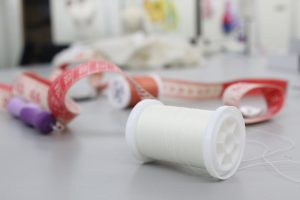
Erin Schaut lays her sewing tools out onto a table.
As a student in the textiles and fashion design program at UW-Madison, Schaut designs real and wearable garments with the goal and belief that she’ll one day have a professional career in fashion.
The capacity to tune out the naysayers made a world of difference for Schaut, who says she was up against opinions like, “No you can’t do that, you’re from Wisconsin. You can’t succeed, you’re no one. You don’t know anyone.”
An admissions interview with North Carolina State University’s fashion and textile design program was somewhat of a defining moment for Schaut. “How do you view clothes and design?” the interviewer asked, which she answered with a profound “It’s everywhere.” She was met with an even bigger-picture way to conceptualize the design world: “It’s everything,” her interviewer replied, “Every type of thing is designed by someone.”
That statement made Schaut think, “I can do it. I can fit in.”
Mark Jansky, a classmate of Schaut’s, completed a bachelor’s degree in journalism with an emphasis in advertising at UW-Whitewater before enrolling at UW-Madison for a second degree in the textiles and fashion design program. Like fashion bloggers Green and Kieck, who held roles in more traditional careers before entering the fashion industry, he took an alternative route before committing to fashion design as a full-time undertaking.
With a merchandising job at Zara in Chicago, Jansky’s desires to pursue fashion weren’t entirely fulfilled, and he made the choice to delve into learning and honing the craft of design at UW-Madison. His interest, he says, “started with just liking clothing and putting together outfits.”

A design sketch of a dress hangs on the wall of a studio next to fabric samples.
Jansky keeps up with high-end luxury designers, although he finds doing so to be a challenge in Madison.
“There are a couple people who are really, really into it, but it’s definitely a niche interest more than anything,” he says. “It’s a little difficult just because it’s hard to find experience in the kind of fashion I’d like to go into.”
Jansky believes there is a certain level of perseverance required of people looking to pursue fashion education in Wisconsin. Because it is so niche, those who are planning to pursue it are likely really interested in it, he says. “One thing that is an advantage is … there isn’t so much of a fashion establishment here,” he says. “You have a little bit more freedom from the influence of others and from a particular scene, and you’re kind of able to create your own thing.”
Demonstrating the unique mindset required of a hopeful designer, Jansky likened the idea of pursuing fashion education within the state lines of Wisconsin to a European movement in the ’90s. “Martin Margiela and all those guys,” Jansky says, referring to the luxury designer famous for his eponymous label, “they kind of came about because they were at the Royal Academy over in Antwerp and it was kind of this — I guess, not ‘anti-fashion’ scene, but it was away from the fashion mainstream of Paris and Milan.”
“They created this whole movement that was different than everything else that was going on, because they were in a little bit of an isolated environment,” he adds. “ I could see a similar effect taking place here, possibly.”
Learn more about the fashion industry
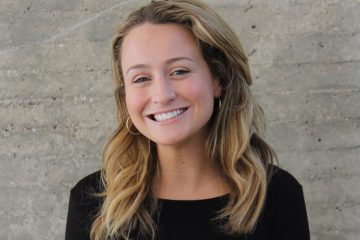
Claudia Prevete | Online Associate
Senior studying both journalism and strategic communication
